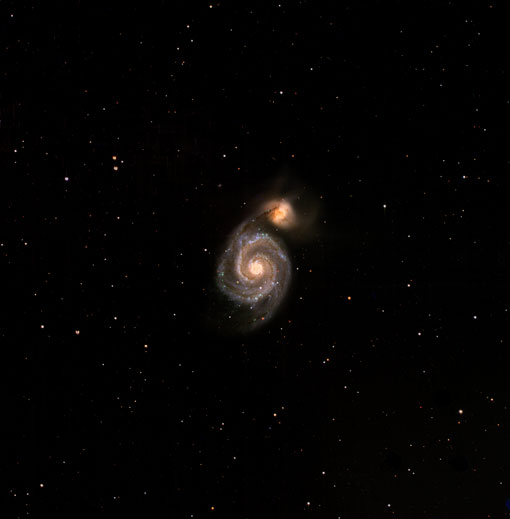|
|
| MPIA Science Release 2010-06-16 |
|
| German version |
Astronomers' first "movie of the sky":
Pan-STARRS survey starts science mission
The Pan-STARRS project has begun a unique program of observing three quarters of the night sky: the systematic search for astronomical objects that change over time. Its data will enable astronomers to search for dangerous asteroids on a possible collision course with Earth, but also to tackle some of astronomy's deepest mysteries: Dark Matter and Dark Energy. Scientists of the Max Planck Institutes for Astronomy and for Extraterrestrial Physics are involved in a number of the survey's key projects, including searches for extra-solar planets, for "failed stars" known as Brown Dwarfs, and for distant active galaxies.
 |
Fig. 1: The Pan-STARRS1 observatory on Haleakala, Maui, just before sunrise. Credit: Rob Ratowski [Larger version for download] |
| Contact | More information | Images for download |
The timeless configuration of stars in the night sky is a veritable symbol of changelessness. Yet closer inspection reveals that there is action in the sky – from objects such as variable stars to rare events such as stellar explosions which are visible for a brief period of time only. A new survey specifically targets such celestial change: Pan-STARRS1 will make repeated observations that should cover all regions within 75% of the night sky at least 30 times, while regions of special interest will be observed several hundred times. The result is a unique "movie of the sky".
"Every month, Pan-STARRS1 will observe one sixth of the sky at five different wavelengths" explains Dr. Roberto Saglia of the Max Planck Institute for Extraterrestrial Physics. "In this way, we can track changes in brightness. We can also use our data for an especially deep look into certain regions of the sky." These regions are observed every night. The resulting data will also be used to draw a particularly detailed three-dimensional map of the Milky Way Galaxy, our cosmic home, and to produce a complete inventory of variable astronomical objects for our cosmic neighbour, the Andromeda galaxy.
Pan-STARRS1 also acts as a classical survey, where astronomers look for known types of celestial objects. It will search, among other things, for extremely faint and red objects, such as Brown Dwarfs (objects that do not have sufficient mass to evolve into proper stars) and the earliest active galaxies ("quasars at redshift z = 7") at distances of more than 13 billion light-years. Another part of the search has a very practical goal: Pan-STARRS1 is set to chart asteroids that could potentially collide with Earth in a catastrophic "global impact" event.
Pan-STARRS' repeated observations of large regions of the sky make it the ideal tool to track phenomena that change over time. A key example are "transiting exoplanets" – planets around distant stars that, as seen from Earth, periodically move in front of their mother star, obscuring a tiny fraction of the star's light and thus causing a slight dip in its apparent brightness. Its observational strategy also increases the chances of Pan-STARRS1 to observe very rare, ephemeral phenomena. An example: With luck, the survey could catch a distant galaxy's central black hole in the act of swallowing a star – an event that leads to an increase in brightness that lasts only a few days. In addition, Pan-STARRS1 astronomers brace for the unexpected. "Whenever astronomers have tried out a new way of looking at the sky, they've been in for surprises," says Prof. Dr. Hans-Walter Rix of the Max Planck Institute for Astronomy. "Pan-STARRS1 is the first systematic, large-scale survey of time-dependent phenomena in the night sky. If history is any guide, we are bound to find something completely new."
Conceived and designed at the University of Hawaii Institute for Astronomy (IfA), the Pan-STARRS1 observatory sits atop the dormant volcano Haleakala but is operated remotely from the Advanced Technology Research Center in Pukalani, Maui. The telescope currently in operation, PanSTARRS1 (PS1) is the prototype whose operation is meant to lead to a larger, more complete survey involving four telescopes of the same type. "PS1 has been taking science-quality data for six months, but now we are doing it dusk-to-dawn every night," says Dr. Nick Kaiser, the IfA scientist who is the principal investigator of the Pan-STARRS project. This marks the transition from the telescope's commissioning and testing phase to science operations.
With a 1.8-meter primary mirror, the PS1 telescope is modest in size – at least by the standards of modern professional astronomy. But PS1 has unique properties, namely an extraordinary field of view more than thirty times the size of the full moon. Mounted on the back of the telescope is the 1.4-Gigapixel camera (which is about the size of a telephone booth) that makes PS1 the world’s most powerful survey telescope.
Now that the PS1 telescope has started to take data, the observatory will produce several Petabytes of data over the next years, enough to fill on the order of 1000 DVDs every night. To master this relentless stream of data, a new Pan-STARRS1 computer cluster was built at the Garching computer centre. With 150 TB of storage space on hard disc for rapid data reduction and analysis, long-term storage on magnetic tapes, and 700 CPUs, this new cluster is hard at work churning through the first Pan-STARRS1 survey data. The analysis employs custom-made software that enables astronomers to automate the first steps in the classification of the astronomical objects observed, providing automatic measurements of key properties such as the temperature and metallicity of stars, or the redshift of distant objects.
| top |
Contact
Dr. Bertrand Goldman
Max Planck Institute for Astronomy, Heidelberg
Tel.: +49 6221 528 260
email: goldman@mpia.de
Dr. Markus Pössel (Public relations)
Max Planck Institute for Astronomy, Heidelberg
Tel.: +49 6221 528 261
email: poessel@mpia.de
Dr. Hannelore Hämmerle (publicist)
Max Planck Institute for extraterrestrial Physics, Garching
Tel.: +49 89 30000-3980
email: hannelore.haemmerle@mpe.mpg.de
Dr. Roberto Saglia
Max Planck Institute for extraterrestrial Physics, Garching
Tel.: +49 89 30000-3916
email: saglia@mpe.mpg.de
Dr. Klaus Jäger
Max Planck Institute for Astronomy, Heidelberg
Tel.: +49 6221 528 379
email: jaeger@mpia.de
Dipl.-Phys. Axel Quetz
Max Planck Institute for Astronomy, Heidelberg
Tel.: +49 6221 528 273
email: quetz@mpia.de
| top |
More information about Pan-STARRS
Pan-STARRS (short for "Panoramic Survey Telescope & Rapid Response System") combines a superb observing site with the technical and the scientific expertise available in Hawaii and among the collaboration's international partners. Funding for the development of the observing system has been provided by the U.S. Air Force. The project plans to build the full four-telescope Pan-STARRS array that will quadruple the light-gathering capability of PS1. Pan-STARRS1 is the first large-scale optical survey since the ten-year Sloan Digital Sky Survey (SDSS); in contrast with SDSS, Pan-STARRS1 observations include the main plane of the Milky Way galaxy, promising a wealth of data about our cosmic home. Pan-STARRS1 will collect optical and infrared data like SDSS in the standard filters g, r, i, and z, but also in the y-band to take advantage of the excellent detector capabilities of Pan-STARRS in the near infrared.
The PS1 Surveys have been made possible through contributions of the PS1
Science Consortium: One third of the contributions come from the Institute for Astronomy, the University of Hawaii with its Pan-STARRS Project Office; an additional third is provided by the Max-Planck Society and its participating institutes, the Max Planck Institute for Astronomy, Heidelberg, and the Max Planck Institute for Extraterrestrial Physics, Garching; the remaining third is provided by a consortium of institutions mostly from the US and the UK: the Johns Hopkins University; the University of Durham; the University of Edinburgh; the Queen’s University Belfast; the Harvard-Smithsonian Center for Astrophysics; the Los Cumbres Observatory Global Telescope Network, Inc.; and the National Central University of Taiwan.
More information on the PS1 science Consortium: http://ps1sc.org
 |
Fig. 2: The galaxy M51 and its companion NGC 5195 as seen by Pan-STARRS1. In the full resolution version, each pixel represents the native resolution of 0.26 arcsec. Credit: Pan-STARRS, Institute for Astronomy, University of Hawaii [Larger version for download] |
| top |
| Name | Format | Color Space |
Resolution | Size | |
 |
PR100616_1.jpg | JPG | RGB | 510 x 340 pxl / 72 dpi | 60 KB |
| PR100616_1gr.jpg | JPG | RGB | 800 x 533 pxl / 72 dpi | 116 KB | |
| PR100616_1hr.tif | JPG | RGB | 1700 x 1133 pxl / 72 dpi | 296 KB | |
 |
PR100615_2.jpg | JPG | RGB | 510 x 248 pxl / 72 dpi | 12 KB |
| PR100616_2gr.jpg | JPG | RGB | 1200 x 583 pxl / 72 dpi | 32 KB | |
| PR100616_2hr.jpg | JPG | RGB | 8760 x 8920 / 72 dpi | 28,1 MB | |
| PR100616_2hr.tif | TIF | RGB | 8760 x 8920 / 72 dpi | 298,7 MB | |
| top |